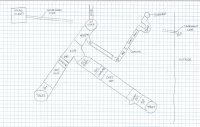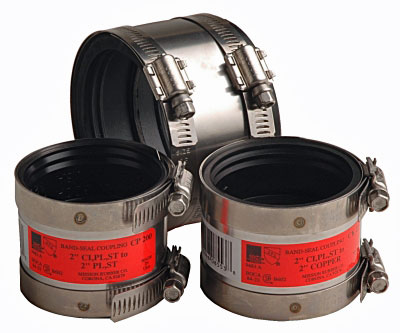Hi all,
Last night I was showering and heard a gurgling sound. I figured out that when I ran the shower that both toilets in the "Jack & Jill" (double) bathroom were gulping air from the bowl. When I tried flushing the toilet, it just filled with water and then slowly drained. I believe this all indicates that the main line has a partial clog, is filling with water, and is not able to pull air from the main vent. This results in the toilets turning into the vents and they gulp for air.
I have attached a sketch I drew of this bathroom's plumbing. I made this sketch when I did a recent bathroom remodel and this is actually the "before" sketch. The cast iron has all been replaced with PVC and the shower no longer has a 90-degree turn, but the basic layout is otherwise the same. This is a "wet vent" system and the 4" stack vents to the roof.
My first question is: does this most likely seem like a partial clog in the main line? Are there any other possibilities, such as a problem at the street (i.e., the city's problem)? I should note that there has been quite a bit of city plumbing being done in my area over the last year.
If the problem is indeed a partial clog in the main line, I believe the solution in this case is normally to get a camera inspection and snaking.
However, I'm wondering if an alternate approach would make more sense. When I did my recent remodel, I did not replace the 1960s cast iron main line that runs from my crawlspace to the street. I was planning on replacing the main line with PVC this winter or spring based on the logic that the the cast iron line had reached the end of its service life.
Consequently, I am wondering if I should simply replace my main sewer line now and not bother with an inspection or snaking. Since I was planning on the replacement anyway, I would save the $200 - $600 (guessing) on the camera inspection and snaking. For all I know, the inspection may reveal a partially collapsed line or some other catastrophic problem that would require replacing the main line anyway.
My second question is: is it possible to replace a partially clogged main line without first snaking it? I can imagine a situation where the clog has caused sewage backup and attempting to just remove and replace the line would cause a messy problem.
Any suggestions are welcome! Thanks for reading.
Last night I was showering and heard a gurgling sound. I figured out that when I ran the shower that both toilets in the "Jack & Jill" (double) bathroom were gulping air from the bowl. When I tried flushing the toilet, it just filled with water and then slowly drained. I believe this all indicates that the main line has a partial clog, is filling with water, and is not able to pull air from the main vent. This results in the toilets turning into the vents and they gulp for air.
I have attached a sketch I drew of this bathroom's plumbing. I made this sketch when I did a recent bathroom remodel and this is actually the "before" sketch. The cast iron has all been replaced with PVC and the shower no longer has a 90-degree turn, but the basic layout is otherwise the same. This is a "wet vent" system and the 4" stack vents to the roof.
My first question is: does this most likely seem like a partial clog in the main line? Are there any other possibilities, such as a problem at the street (i.e., the city's problem)? I should note that there has been quite a bit of city plumbing being done in my area over the last year.
If the problem is indeed a partial clog in the main line, I believe the solution in this case is normally to get a camera inspection and snaking.
However, I'm wondering if an alternate approach would make more sense. When I did my recent remodel, I did not replace the 1960s cast iron main line that runs from my crawlspace to the street. I was planning on replacing the main line with PVC this winter or spring based on the logic that the the cast iron line had reached the end of its service life.
Consequently, I am wondering if I should simply replace my main sewer line now and not bother with an inspection or snaking. Since I was planning on the replacement anyway, I would save the $200 - $600 (guessing) on the camera inspection and snaking. For all I know, the inspection may reveal a partially collapsed line or some other catastrophic problem that would require replacing the main line anyway.
My second question is: is it possible to replace a partially clogged main line without first snaking it? I can imagine a situation where the clog has caused sewage backup and attempting to just remove and replace the line would cause a messy problem.
Any suggestions are welcome! Thanks for reading.


